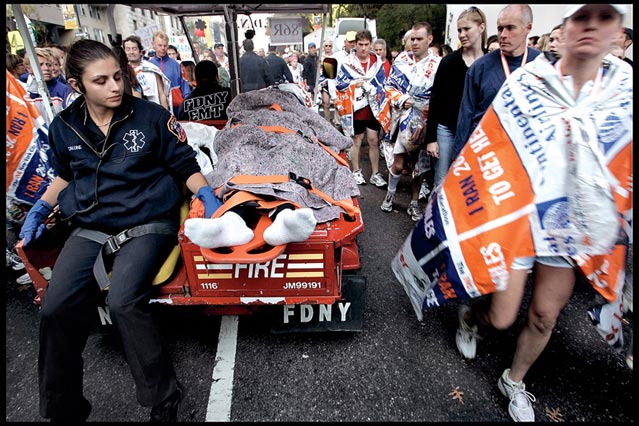PETER HASS HAD BEEN running for about two hours when he collapsed at the finish line of San Francisco’s last February. The race’s only medical team, which included chiropractors but no M.D.’s, had been called away to deal with another emergency, so a doctor who happened to be running the race performed CPR. Meanwhile, the race announcer issued calls for help over the loudspeaker. The nearest city paramedics arrived 22 minutes later. By the time they reached the 36-year-old Hass, .
By the Numbers
April 16, 2012: Date of the 116th running of the Boston Marathon27,000: Runners who will start the race this year
65–70: Doctors typically on hand
1,300: First-aid volunteers, including nurses, medical students, and physical therapists
1,500: Runners who typically require some level of medical attention during or immediately following the race
Last year, 13 Americans died during running races, and another eight while competing in triathlons. While those numbers might seem troubling, the deaths are attributable mostly to the booming popularity of endurance sports—13 million Americans enter running races each year, and 2.3 million compete in triathlons. But the rising participation and the proportional death toll—especially in cases like Hass’s—highlight the need for quality medical care at these events. And usually that care comes from volunteer doctors.
At least it used to. More and more doctors are refusing to donate their services, and it’s for one frustrating reason: they can’t get medical-malpractice insurance. Most doctors’ insurers typically won’t issue one-day policy riders for sporting events, and race organizers haven’t stepped up to offer alternative coverage. After the 2008 , volunteer medical director Franklin Marcus famously resigned because race organizers had refused to offer coverage.
While some doctors are still willing to volunteer, many events have been dangerously understaffed. Kathy Matejka, event-services director for , the official governing body of the sport in the U.S., acknowledged that doctors have been unable or unwilling to take on the risk of volunteer service absent the umbrella of malpractice coverage. The result “was compromised medical support in some instances.”
The truth is, individual physicians may not have much to fear. �����ԹϺ��� was unable to find any American doctor who’d been named in an event-related lawsuit. This is because plaintiffs typically go after race organizers, who have deeper pockets.
But while the risk of lawsuits may be overblown, the threat of not having enough qualified doctors on hand is very real. One man attempting to fix the problem is , president of the World Road Race Medical Society and medical director for the Chicago Marathon since 2007. Chiampas, who notes that Good Samaritan laws cover doctors only if they’re bystanding fans and not official event volunteers, teamed with and sports insurance company to create policies specifically for volunteer medical teams. Beginning in 2009, all five major U.S. marathons—Chicago, New York, Twin Cities, Boston, and Houston—bought the plan, at a cost of $50 to $60 per doctor. USAT began offering the program last year.
Surprisingly, Ironman’s organizers learned about USAT’s insurance option only when they were contacted for this story. They subsequently purchased policies for 75 volunteer doctors at last October’s Ironman World Championship in Hawaii.
But even at $60 per doctor, not all event-marketing companies have jumped on board to cover their M.D.’s. Several large adventure races, like and , hire private paramedic services, like STAT Medical, to be on standby. Smaller events, like local 10Ks and sprint triathlons, use uninsured volunteers. And still others, like , producers of the Rock ’n’ Roll Marathon series and other endurance competitions, won’t discuss their policies.
That bothers ESIX president Mike Price, who thinks insuring doctors is a no-brainer, not something to keep secret. Having insurance “means an event is able to attract and retain more doctors of higher credentials, ensuring that the athletes have the best medical care available.” That way, racers can concentrate on their performance instead of worrying about whether somebody will be there to help them if they’re in trouble.


